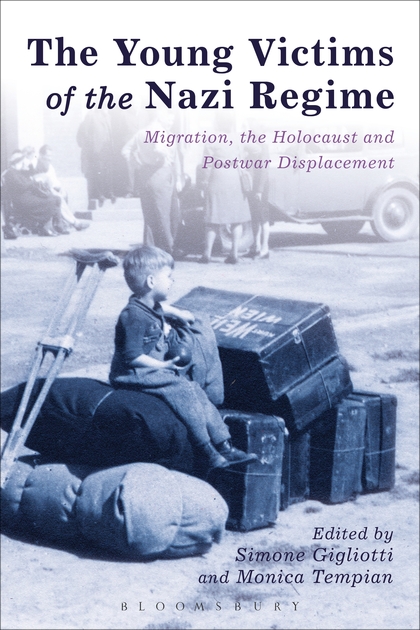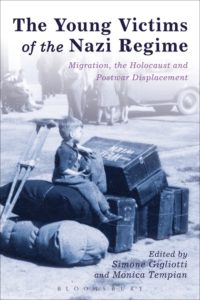
The Young Victims of the Nazi Regime: Migration, the Holocaust and Postwar Displacement edited by Simone Gigliotti and Monica Tempian

This is part of our special feature Governing the Migration Crisis.
As the history of children has taken its place among the important fields of inquiry over the past two decades, and as children’s lives provide valuable insights into human experience, it is inevitable that the children brutalized by Nazi Germany should become historical subjects. These children were already the focus of interviews and sociological studies, as well as the basis for psychological theories, but their history was, in many ways, hidden behind the immense fact that more than one and one half million children were destroyed – their lives largely obliterated from the historian’s gaze. Most of these were Jewish children, though not all as the essays in this volume repeatedly remind us. The fate of children in 1930s and 1940s Europe often paralleled the fate of their parents, and the statistics about and monuments to their deaths include both.
This volume, ably edited by Simone Gigliotti and Monica Tempian, focuses our attention on those children who did not follow in their parents’ path. It documents the survivors of all kinds – those lucky enough to escape Germany, and then Austria, before the war to places as far flung as Canada, the United States, Brazil, Kenya, Australia, and New Zealand; those hidden in convents and among partisans and peasants in France and elsewhere in Europe; those transported to the sanctuary of England as part of the Kindertransport; and those very few who survived the concentration and labor camps, where so many others had been smothered by gas, shot into trenches, and starved to death. It is a story of this remnant, mostly Jews but also Czechs and Poles (in this book) who had been somehow spared from the fate of the others. These few and the lives they undertook during and after the war are the subject of this fascinating book.
Like all volumes of collected essays, this one is somewhat uneven in quality, but given the nature of the subject, the book as a whole provides the reader with a great deal: an extraordinarily broad vantage and many insights into the survival of these children; how they absorbed the fact of their survival into their growth and development; their relationship to Judaism; and their successful adaptation (in most cases) to new lives elsewhere. In the process, the reader learns about the agencies that managed to bring them out of Europe before the war and dealt with them after, as well as the national policies, laws, and politics that enabled and (more often) restricted their admission. The politics of most of the receiving nations were obstructive, and many agencies struggled to arrange for passage; the actions of the agencies themselves were hampered by bureaucracy as well as by the personalities of those involved. The book does not lay blame, though much blame could be placed. By dividing the task of telling this story among many authors, the editors have enlisted the focused expertise of contributors familiar with many different places, so that despite the unevenness of treatment, a sharp picture emerges that is firmly grounded in the deep knowledge of the several authors. An outstanding example of this is Suzanne D. Rutland’s exploration of the policies and bureaucratic tangles that accompanied the flight of child refugees to Australia.
In addition, most authors, with more or less success, have tried to bring the subjects of their inquiry – the children themselves and the adults they became—alive, focusing on selected individuals whose experience, while always unique, is also illustrative of wider patterns. As a result, the essays discuss a range of issues regarding the subjective nature of survivorship, including personal psychology and trauma, questions of guilt and identity, the experience of being outsiders in often hostile settings, and how these children managed to live in places that despite their strangeness somehow became home. The subject of identity lies at the heart of Mary Fraser Kirsh’s fine essay on the Jewish children who became or pretended to be Catholics in France. Kirsh discusses the difficulties that these “lucky” children experienced as they realized that their histories brought great complexity to questions of who they were and how they related to their Jewish background and obligations.
It has been one of the aims of the literature about the Holocaust to disaggregate the experience of loss – a hopeless task in light of the stark numbers associated with Nazi brutality – and this book can be associated with that objective. By excavating the lived experience of survivors and its great variety, the authors have performed a critical service to their readers as well as to their subjects. Kirsh’s essay exemplifies the multiple dimensions that this engages. That this is a daunting task rarely fully achievable does not make it any less worthy of the effort. Readers may not get to know all the subjects dealt with throughout the book intimately, but their presence is felt everywhere in the volume and the editors are to be applauded for emphasizing this as a component of the task for authors.
Some of the essays are particularly effective in this regard. Marlen Eckl’s article on the unusual subject of refugee children in Brazil, and Andrea Hammel’s probing examination of the intergenerational transmission of the problem of survivorship among participants in the Kindertransport to England are notable. But many others also awaken in readers an understanding of the travails involved in escape and the links to death. One of the most interesting and successful is by Avinoam Patt, who demonstrates the relationship between the adolescent heroes of the underground in the Warsaw ghetto (and elsewhere) and the Zionist youth movement that formed in Germany after the war. In the history of these youths who eventually went to Palestine, even death could lead to survival as Patt shows us that people and stories bound the lives of those who died and those who survived together in the new Jewish homeland. And Joanna Sliwa’s touching account of the Krakow Ghetto deals extremely sensitively with what she admits are the fraught challenges of writing about “Jewish children during the Second World War,” when “numerically, few child witnesses survived to tell their wartime stories.” (154)
Since this is a book about memory, the editors have also included several reflections on how the child survivors have been remembered in cultural products. These are, to my mind, the least successful of the many different approaches to the subject covered in the book. Many artistic products have grown from the dank soil of Holocaust survival, but the several authors who address those that focus on children have not only adopted the somewhat murky language of cultural studies but the very nature of the inquiries begin to elide the difference between fact and fiction in ways that do not help in a book where the historical details are so lovingly recovered by the other authors. In dealing with films or written fictionalizations, these contributions do very little to help the reader connect to the subject of the book. Despite its fashionableness, there is something corrosive about mixing these into the issues of child survival. Much as we come to appreciate the layered and difficult nature of individual memory through the other essays, those that attempt to reconstruct cultural memory seem so different as not to belong here at all. In addition to the obscuring the line between fact and fiction, these particular contributions are not notable for their analytic qualities and the editors have chosen comprehensiveness rather than effectiveness in including them.
Overall and in many different ways, the challenges most of the authors of this volume faced and overcame in bringing this book to life are noteworthy. The book will occupy an important space in the growing historiography on children as well as the enormous library of studies of the Holocaust and Nazism. By locating and writing about the survivors, the editors created the kind of children’s history that skeptics too often believe is not possible. It is also a very good example of the new global history. Children always have the potential to introduce a global perspective because of their protean qualities, and these children because of the unusual nature of their survival stories more than most. The children studied in this volume survived by relocating, moving, escaping, hiding, and they eventually settled on every continent. Bound together as a result of the forces of history of which they were the victims, their lives eventually helped to shape the many places that now share in that history.
Historians always find themselves insufficient witnesses to the past since witnessing is reserved to the participants. As Czeslaw Milosz once observed – those who know do not speak and those who speak do not know. And many of the children whom we get to know through this book talked about this confused status in their own attempts to understand the larger story of which they were part but not, of course, in the same way as those who had been slaughtered. In the case of these events and this subject the sense of insufficiency by historians is very great. The authors and editors of The Young Victims of the Nazi Regime provide an important contribution to this subject despite its built-in challenges.
Reviewed by Paula Fass, University of California, Berkley
The Young Victims of the Nazi Regime: Migration, the Holocaust and Postwar Displacement
Edited by Simone Gigliotti and Monica Tempian
Publisher: Bloomsbury
Hardcover / 368 pages / 2016
ISBN: 9781472523907
Published on October 2, 2017.




